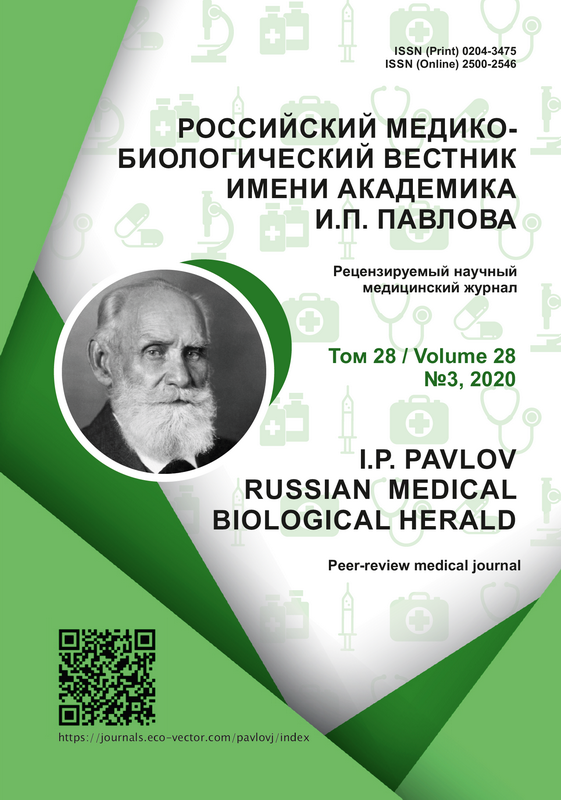Non-invasive diagnostics of endometriosis: review of modern biomarkers of peripheral blood and endometrium
- Authors: Kiselev M.A.1, Repina N.B.2
-
Affiliations:
- City Hospital №3
- Ryazan State Medical University
- Issue: Vol 28, No 3 (2020)
- Pages: 371-376
- Section: Reviews
- Submitted: 18.10.2020
- Accepted: 18.10.2020
- Published: 19.10.2020
- URL: https://journals.eco-vector.com/pavlovj/article/view/47104
- DOI: https://doi.org/10.23888/PAVLOVJ2020283371-376
- ID: 47104
Cite item
Abstract
Endometriosis is a chronic progressing estrogen-dependent disease with a high incidence among females characterized by pelvic pain (40-80%) and infertility (25-80%).
Aim. To analyze and estimate the modern literature data on the possibility of using potential biomarkers of endometriosis in its non-invasive diagnostics.
In recent years, researchers have made significant advances in understanding the disease-specific molecular pathways that regulate the development of ectopic foci of endometriosis, by examining the blood, peritoneal fluid, and eutopic endometrium in women with the disease. Along with understanding the pathophysiology of endometriosis, the question of finding an adequate biomarker that will provide an effective early non-invasive diagnosis of endometriosis and, accordingly, preserve the reproductive health of millions of women, remains relevant.
Conclusion. Most reasonable in diagnostics of endometriosis is a combination of different biomarkers that also minimizes false positive and negative results in differential diagnosis.
Keywords
Full Text
About the authors
Mikhail A. Kiselev
City Hospital №3
Author for correspondence.
Email: michail.kiselev@mail.ru
ORCID iD: 0000-0002-8294-9038
SPIN-code: 7098-2877
Obstetrician-Gynecologist
Russian Federation, TambovNatalya. B. Repina
Ryazan State Medical University
Email: michail.kiselev@mail.ru
ORCID iD: 0000-0001-5916-3574
SPIN-code: 4119-5550
MD, PhD, Associate Professor of the Department of Gynecology and Obstetrics
Russian Federation, RyazanReferences
- Devyatova EA, TSaturova KA, Esmurziyeva ZS, et al. Endometriosis. Akusherstvo i Ginekologiya: Novosti, Mneniya, Obucheniye. 2015;(3):91-100. (In Russ).
- Orazov MR. Debating points of endometriosis. Akusherstvo i Ginekologiya: Novosti, Mneniya, Obucheniye. 2016;(3):72-84. (In Russ).
- Yarmolinskaya MI, Tsitskarava DZ, Selkov SA. Cytokins as the markers for non-invasive diagnosis of pelvic endometriosis. Journal of Obstetrics and Women's Diseases. 2015;64(6):6-16. (In Russ). doi: 10.17816/JOWD6466-16
- Cho HY, Kyung MS. CYFRA 21-1 and Placental Growth Factor as Screening Markers for Endometriosis. Medical Science Monitor. 2019;25:1087-1092. doi: 10.12659/MSM.912787
- Jianfa J, Zhaoying J, Min X. Serum and peritoneal fluid levels of interleukin-6 and interleukin-37 as bio-markers for endometriosis. Gynecological Endocrinology. 2019;35(7):571-5. doi: 10.1080/09513590. 2018.1554034
- Qiu X, Lai Z. IL-2 and IL-27 synergistically promote growth and invasion of endometriotic stromal cells by maintaining the balance of IFN-γ and IL-10 in endometriosis. Reproduction. 2020;159(3):251-60. doi:10. 1530/REP-19-0411
- Stefano L, Serena P, Cristina R, et al. Serum Markers for the Noninvasive Diagnosis of Endometriosis. Women's Health. 2016;11(5):603-10. doi:10. 2217/whe.15.46
- Kuessel L, Jaeger-Lansky A, Pateisky P, et al. Cytokeratin-19 as a biomarker in urine and in serum for the diagnosis of endometriosis – a prospective study. Gynecological Endocrinology. 2014;30(1): 38-41. doi: 10.3109/09513590.2013.856409
- Salamatina LV, Shepilova IB, Mestetsky VN. Dinamika platsentarnogo faktora rosta pri ostrom koronarnom syndrome. Zdravookhraneniye Yugry: Opyt i Innovatsii. 2015;3(1):7-11. (In Russ).
- Zucchini C, De Sanctis P, Facchini C, et al. Performance of Circulating Placental Growth Factor as A Screening Marker for Diagnosis of Ovarian Endometriosis: A Pilot Study. International Journal of Fertility & Sterility. 2016;9(4):483-9. doi:10.2207 4/ijfs.2015.4606
- Li J, Guan L, Zhang H, et al. Endometrium metabolomic profiling reveals potential biomarkers for diagnosis of endometriosis at minimal-mild stages. Reproductive Biology and Endocrinology. 2018; 16(1):42. doi: 10.1186/s12958-018-0360-z
- Gallyamova AV, Mnikhovich MV, Vasin IV, et al. Molecular-biological features of ectopic and eutopic endometrium in genital endometriosis. I.P. Pavlov Russian Medical Biological Herald. 2016;24(S2): 43-4. (In Russ).
- Munksgaard PS, Blaakaer J. The association between endometriosis and gynecological cancers and breast cancer: a review of epidemiological data. Gynecologic Oncology. 2011;123(1):157-63. doi:10. 1016/j.ygyno.2011.06.017
- Chen JQ, Russo J. Dysregulation of glucose transport, glycolysis, TCA cycle and glutaminolysis by oncogenes and tumor suppressors in cancer cells. Biochimica et Biophysica Acta. 2012;1826 (2):370-84. doi: 10.1016/j.bbcan.2012.06.004
- Ostrova IV, Avrushchenko MSh, Golubev AM, et al. The Contribution of Brain-Derived Neurotrophic Factor (BDNF) and its TrkB Receptor to Hippocampal Neuron Resistance to Ischemia-Reperfusion (Experimental Study). General Reanimatology. 2018;14 (6):41-50. (In Russ.). doi: 10.15360/1813-9779-2018-6-41-50
- Giannini X, Bucci A, Luisi S, et al. Brain-derived neurotrophic factor in plasma of women with endometriosis. Journal of Endometriosis. 2010;2(3): 144-50. doi: 10.1177/228402651000200305
- Wessels JM, Kay VR, Leyland NA, et al. Assessing brain-derived neurotrophic factor as a novel clinical marker of endometriosis. Fertility and Sterility. 2016; 105(1):119-28. doi: 10.1016/j.fertnstert.2015.09.003
Supplementary files










